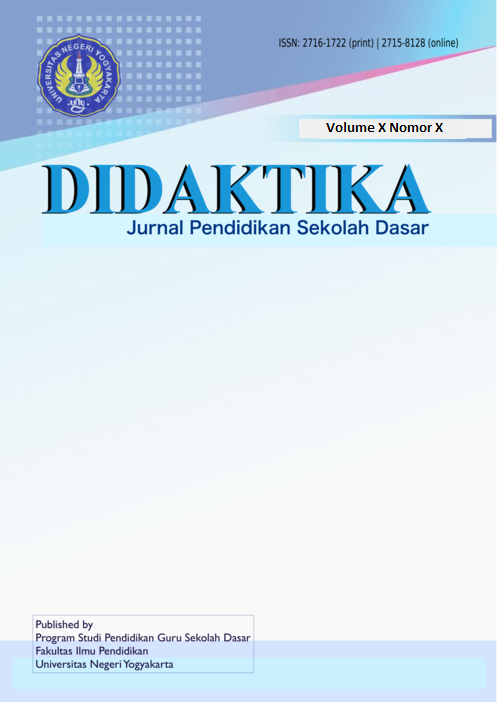Analisis Butir Soal untuk Materi Gaya di Sekolah Dasar
DOI:
https://doi.org/10.21831/didaktika.v3i1.31431Abstract
Item analysis was conducted to assess the quality of items in the style material in grade IV elementary school. To achieve this goal, four points were examined in this study, including (1) item validity, (2) reliability, (3) difficulty level, and (4) item discrimination power. This research is a quantitative descriptive research. The subjects of this study were 27 grade IV students at Kentungan Elementary School in February 2020. Quantitative data analysis techniques were carried out to determine the validity, reliability, difficulty level, and distinguishing features using the SPSS 17 application program. The results of this study were: (1 ) there are 15 valid questions in each cycle, (2) the level of reliability in the high category both in cycle I and cycle II, (3) in cycle I, there are 8 easy questions, 6 medium questions, and 1 difficult problem, whereas in cycle II, there are 8 easy questions and 7 moderate questions, (4) Related to the power of distinguishing questions, in cycle I, there are 8 questions in the excellent category, 6 good questions, and 1 sufficient problem, whereas in cycle II, there are 14 good questions and 1 question is enough.
Keywords: item analysis, validity, reliability, item difficulty level, item discrimination power
References
Arikunto, S. (2012). Dasar-dasar evaluasi pendidikan. Jakarta: PT Bumi Aksara.
Arikunto, S. (2018). Dasar-dasar evaluasi pendidikan. Jakarta: PT Bumi Aksara.
Basuki, I. dan Hariyanto. (2014). Asesmen pembelajaran. Bandung: PT Remaja Rosdakarya.
Darmawan, R. (2013). Metode penelitian kuantitatif. Bandung: PT Remaja Rosdakarya.
Daryanto, H. (2017). Evakuasi pendidikan: komponen MKDK. Jakarta: Rineka Cipta.
Herwin. (2019). Evaluasi program pembelajaran IPS di Sekolah Dasar Negeri 126 Lagoe. Didaktika Jurnal Pendidikan Sekolah Dasar, Vol. 2. No. 2.
Hofmeister, P., Jaeger, T. F., Arnon, I., Sag, I. A., & Snider, N. (2013). The source ambiguity problem: Distinguishing the effects of grammar and processing on acceptability judgments. Language and Cognitive Processes, 28(1-2), 48-87.
Jihad, A. & Abdul H. (2012). Evaluasi pembelajaran. Yogyakarta: Multi Pressindo.
Kusaeri dan Suprananto. (2012). Pengukuran dan penilaian pendidikan. Yogyakarta: Graha Ilmu.
LeBreton, J. M., & Senter, J. L. (2008). Answers to 20 questions about interrater reliability and interrater agreement. Organizational research methods, 11(4), 815-852.
Martini, S. (2019). Peningkatan hasil belajar siswa pada materi energi gerakan melalui model Contextual Teaching and Learning (CTL) pada siswa sekolah dasar. Didaktika Jurnal Pendidikan Sekolah Dasar, Vol 2. No. 2.
Masidjo. (1995). Penilaian pencapaian hasil belajar siswa di sekolah. Yogyakarta: Penerbit Kanisius.
Pidekso, A. (2009). SPSS 17 untuk pengolahan data statistik. Yogyakarta: CV Andi Offset.
Purwanto. (2009). Evaluasi hasil belajar. Yogyakarta: Pustaka Pelajar.
Rusdiana & Elis R. (2015). Evaluasi pembelajaran. Bandung: CV Pustaka Setia.
Sani, R.A. (2016). Penilaian autentik. Jakarta: PT Bumi Aksara.
Sanjaya, W. (2011). Penelitian tindakan kelas. Jakarta: Kencana Prenada Media Group.
Subali, B. (2012). Prinsip asesmen & evaluasi pembelajaran. Yogyakarta: UNY Press.
Susetyo, B. (2011). Menyusun tes hasil belajar. Bandung: CV Cakra.
Uno, H.B. & Satria, K. (2012). Assessment pembelajaran. Jakarta: PT Bumi Aksara.
Waddington, C. (2001). Different methods of evaluating student translations: The question of validity. Meta: journal des traducteurs/Meta: Translators' Journal, 46(2), 311-325.
Widoyoko, E.S. (2009). Evaluasi dan program pembelajaran. Yogyakarta: Pustaka Pelajar.
Wu, J., King, K. M., Witkiewitz, K., Racz, S. J., & McMahon, R. J. (2012). Item analysis and differential item functioning of a brief conduct problem screen. Psychological assessment, 24 (2), 444.
Downloads
Published
How to Cite
Issue
Section
Citation Check
License
- Authors retain copyright and grant the journal right of first publication with the work simultaneously licensed under a Creative Commons Attribution License that allows others to share the work with an acknowledgement of the work's authorship and initial publication in this journal.
- Authors are able to enter into separate, additional contractual arrangements for the non-exclusive distribution of the journal's published version of the work (e.g., post it to an institutional repository or publish it in a book), with an acknowledgement of its initial publication in this journal.
- Authors are permitted and encouraged to post their work online (e.g., in institutional repositories or on their website) prior to and during the submission process, as it can lead to productive exchanges, as well as earlier and greater citation of published work.






